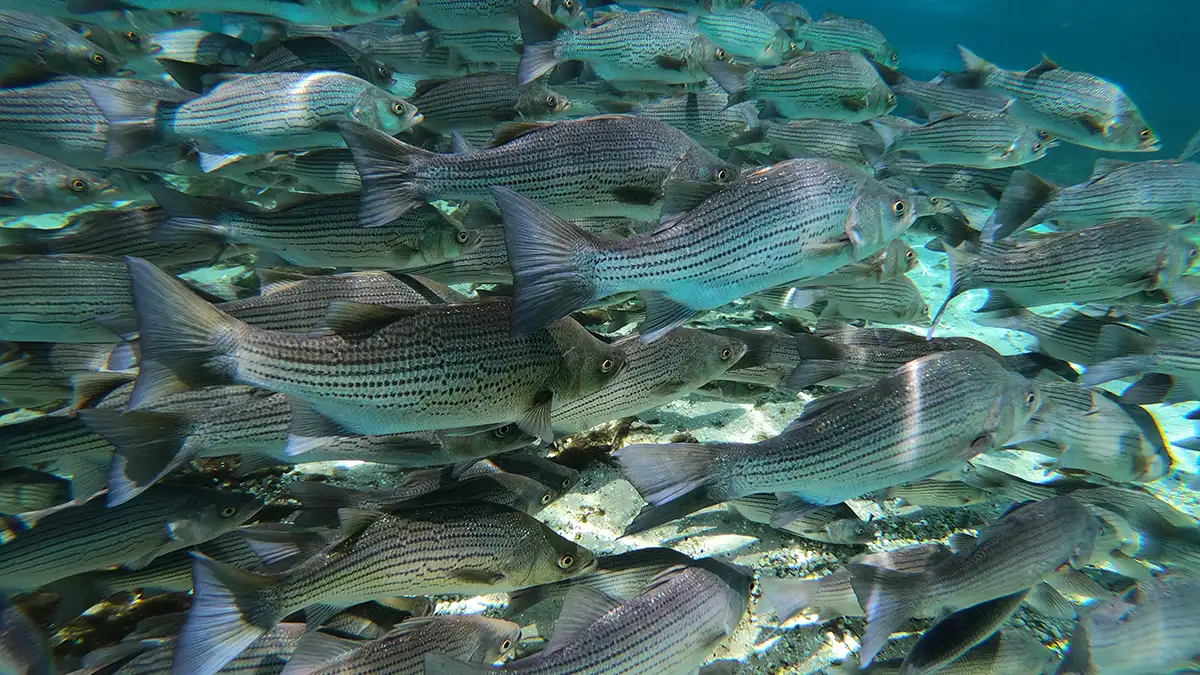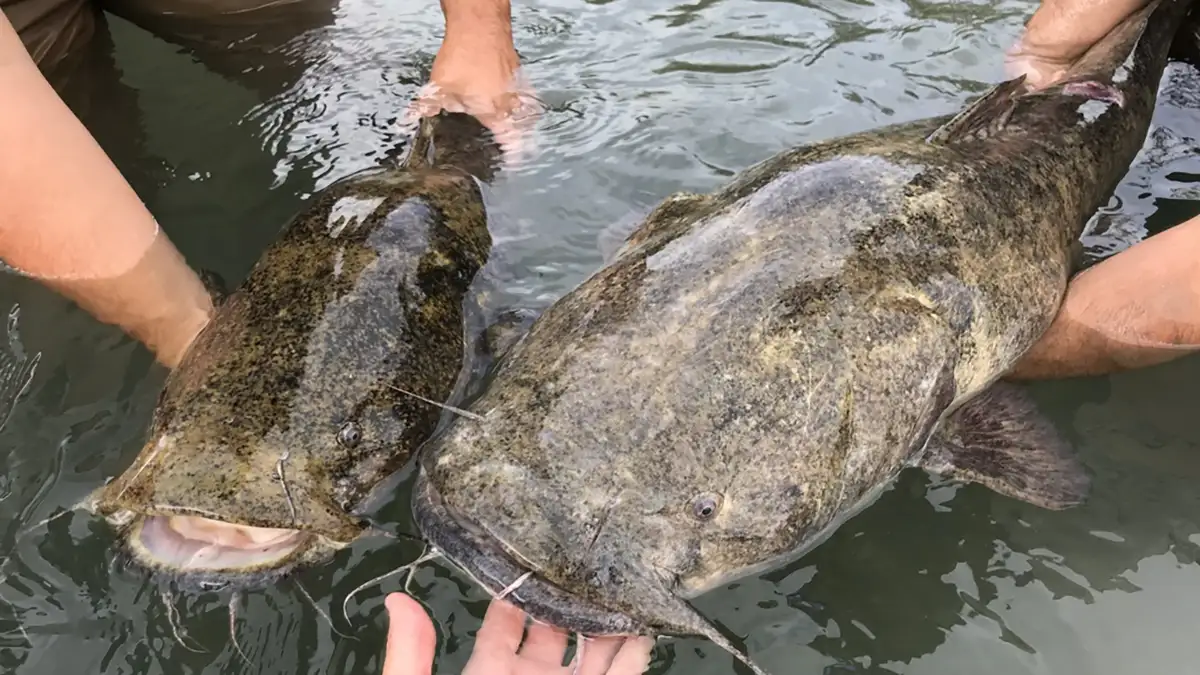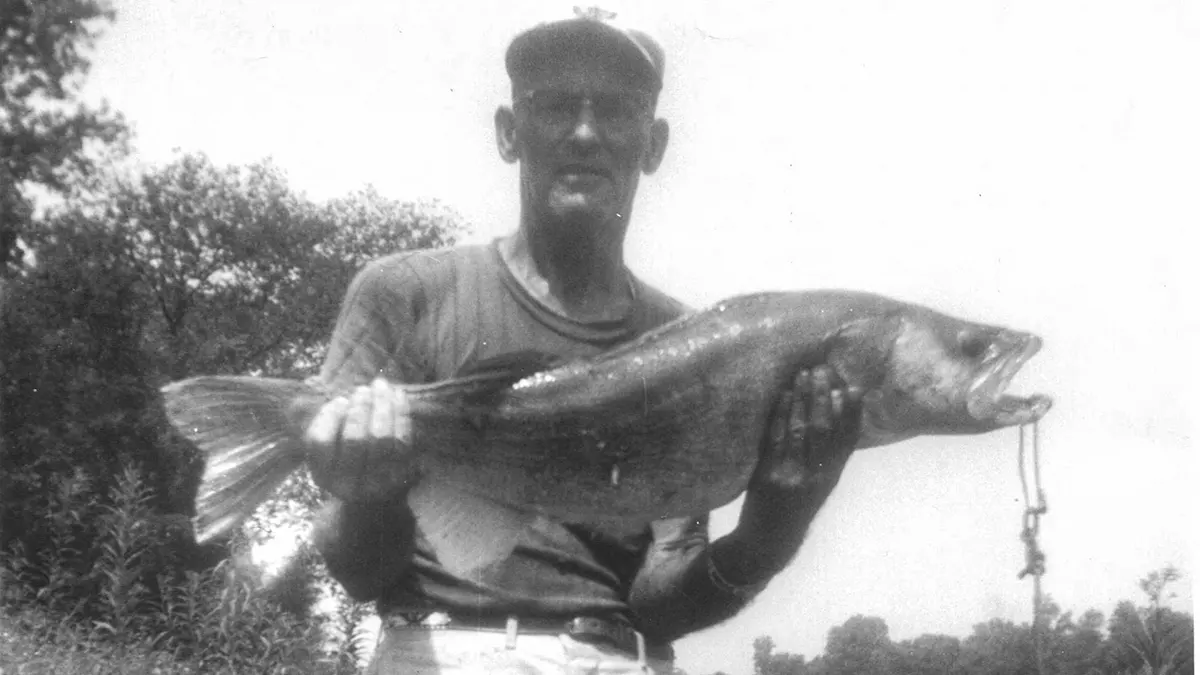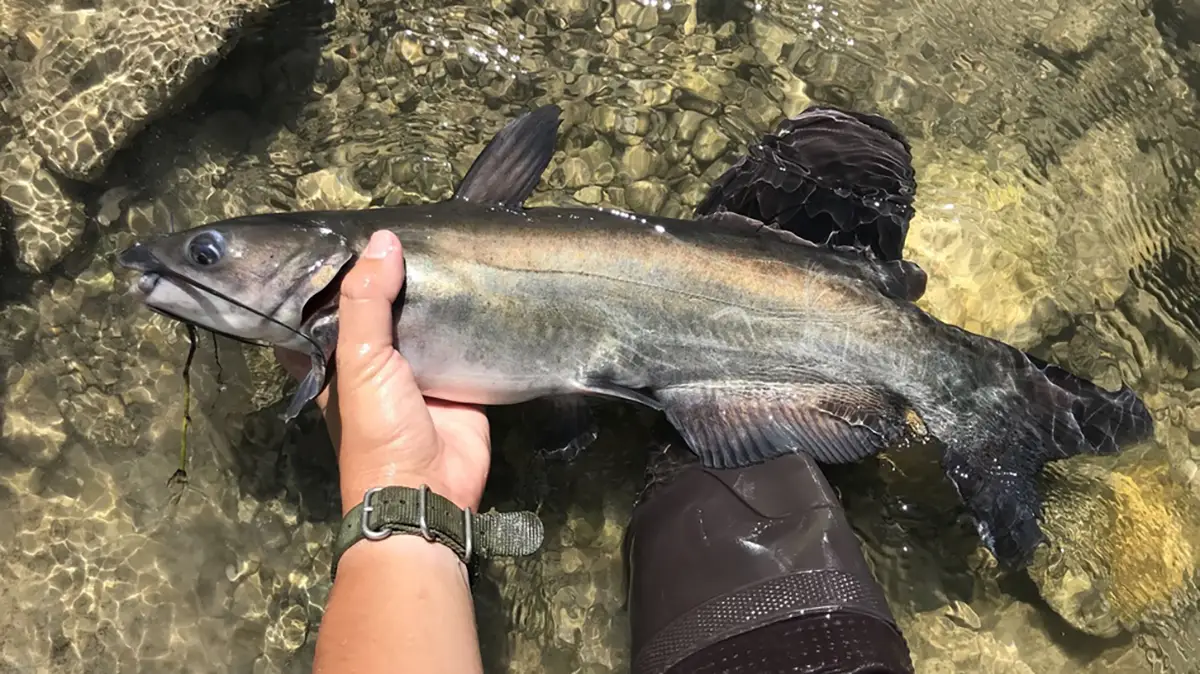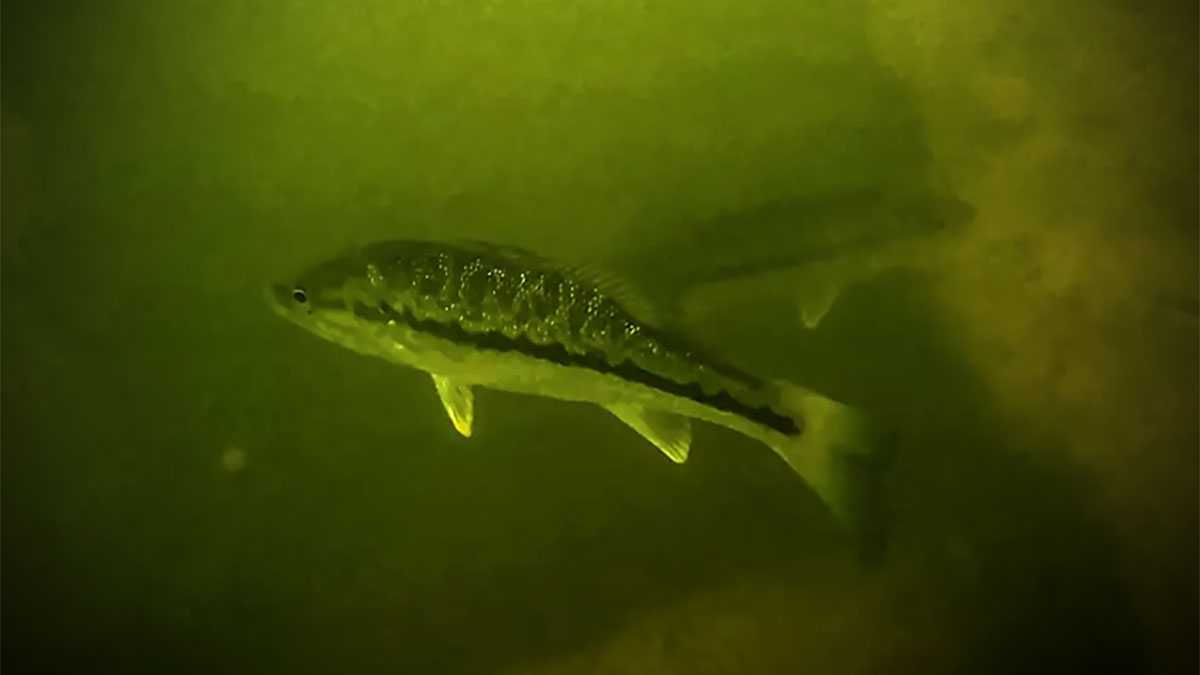The striped bass is one of the most powerful sportfish you can find in freshwater, and the hybrid striped bass is one of the most commonly stocked sportfish in the US. Hybrids, as they are commonly referred as by anglers, are a cross between one of the smallest members of the Moronidae family, the white bass, and the largest, the striped bass. This fish continues to rise in popularity among fisheries managers and anglers who are looking for an extraordinary fishing opportunity. In this species profile, we will cover everything you need to know about the striped bass and their popular hybrid offspring.
Striped Bass History
Striped bass are a member of the family Moronidae which are known as true or temperate bass. This family includes the Dicentrarchus and Morone species. The Dicentrarchus contains two living species, the European seabass and the spotted sea bass, both found in coastal European Atlantic Ocean and Mediterranean Sea areas. The four Morone species are found exclusively in North America and primarily in brackish and freshwater environments. They include white perch, white bass, yellow bass, and striped bass. Artificial spawning between Morone species can create a number of different hybrid striped bass, but natural hybridization is very rare. The most common hybrids are the palmetto bass (female striped bass x male white bass) and the sunshine bass (male striped bass x female white bass).
Striped bass were first described by Johann Walbaum in 1792. He was an ichthyologist known for describing unknown fish species. The scientific name is Morone saxatilis. The saxatilis name was originally given by Walbaum and means living among rocks.
Striped bass are known by many common names, including striper, rockfish, lineside, greenhead, and squid chaser. Hybrid striped bass are known as hybrids, wipers, and white rock bass.

Striped Bass Identification
Striped bass have elongated bodies that are fairly thin. The majority of their body is silver in coloration with a dark gray to green upper back and a white stomach. The striped bass has 7 to 8 obvious horizontal stripes that extend from the operculum down their sides. One of the stripes will follow the lateral line, and one should be visible below the pectoral fin.
The striped bass has separated spiny and soft dorsal fins. The spiny dorsal will have 8 to 10 spines, and the soft dorsal will have 10 to 13 rays. The operculum or gill cover has two sharp spines. The mouth of the striper has a slight lower jaw protrusion. When the mouth is closed, the upper jaw will extend to the middle of the eye. The striper’s pectoral fins will have 14 to 16 rays and the anal fin will have 3 spines and 10 to 12 rays. The caudal fin is deeply forked. The anal and pelvic fins are light in coloration, while the dorsal, pectoral, and caudal fins are darker pigmentation.
Individual fish can be further separated by doing scale, spines, and ray counts or via DNA analysis to determine their original geographic lineage.
Hybrids can be somewhat difficult to distinguish from striped and white bass. The primary difference between hybrid striped bass and striped bass is the lateral stripes of hybrids will generally be broken and their body depth is thicker. Striped bass will have a body that is fairly compressed, while hybrids will have a shorter length and broader shoulder. The primary difference between hybrid striped bass and white bass is the tooth patch on the tongue. White bass have only one central tooth patch, while hybrids should have two.
Striped Bass Location
Striped bass and their hybrids are now regularly stocked in reservoirs throughout the US to provide sportfishing opportunities. Before stocking programs began, their distribution was limited to the east coast and Gulf of Mexico estuary and riparian systems. Their northern boundary was the St. Lawrence in Quebec, Canada. They could be found in river systems on the Atlantic coast south of Quebec to the St. Johns River in Florida. To the west, they were in the Gulf of Mexico to Lake Pontchartrain, Louisiana. Their inland distribution continued upstream is typically 4 miles or less, but rare instances of fish migrating beyond 200 miles were recorded.
To establish sportfishing opportunities beginning in 1877, striped bass were introduced to the Pacific coast. With the expansion of dam construction and impoundment of reservoirs, striped bass stockings increased in popularity. They have expanded outside North America to Russia, France, and Portugal.
Today hybrids are stocked more often than pure striped bass due to their ability to grow faster, with better survival, and increased catchability. The first palmetto hybrids were stocked in 1965 in South Carolina. The first sunshine bass were stocked in 1973. Hybrid striped bass can be found throughout reservoirs in the US. Their popularity has expanded beyond the US and into Canada, Mexico, South Africa, Iran, Turkey, Russia, Argentina, Ecuador, and Hawaii.
To visualize the historic and current distribution of striped bass we have created this interactive map:
Striper Spawning
Striped bass live primarily in brackish water but spawn in freshwater. They migrate from coastal regions upstream as far as 200 miles inland. Today, migration and non-migration populations exist due to the reservoir system. Many spawning populations congregate at the discharge behind large spillways.
Spawning is triggered as water temperature increases beyond 60 degrees. Peak spawning is between 65 to 70 degrees and ends above 75 degrees. Spawning occurs in February in the southern reaches of Florida and as late as July in the northern reaches of Quebec.
Females develop their eggs throughout the previous summer and fall but do not necessarily spawn annually. Striped bass females can even carry egg masses for several years. A single female can produce 15,000 to 40,000,000 eggs based on her size. Female striped bass spawn with multiple males in large groups. The process begins with vigorous surfacing activity and the female broadcasting eggs that males fertilize as they drift through the current. The eggs are non-adhesive and semi-buoyant. They must be fertilized within 1 hour or they will become non-viable. Fertilized eggs slowly sink and are carried through the current downstream. The success of spawning is determined by the depth, current, and if the eggs are caught in sediment. Muddy, silty, or clay soils can cause low egg survival, while large boulders and rock are typically safer and allow eggs to still hatch.
Eggs are initially small and transparent, with a diameter of .04 inches or less. The egg slowly hardens and increases in size to .1 inches in diameter. As eggs roll in the current, they will hatch in 2 to 4 days, depending on the water temperature.
Hybrid striped bass are actually able to produce eggs and sperm. Although natural reproduction is very improbable in the wild, hybrids will participate in spawning migrations with striped and white bass in some reservoirs. In lab conditions hybrid striped bass spawning can be accomplished.

Size and Lifespan
When stripers eggs hatch, the larval fish are around .2 inches long. They slowly absorb their yolk sac over 1 to 2 weeks. They must gulp air to fill their swim bladder as soon as their mouth develops from day 10 to 13. They form schools and migrate inshore when they reach 1/2 inch. Within 20 to 30 days, striped bass fry reach 1 inch in length and continue to live in schools of several thousand fish as juveniles.
Both hybrid stripers and pure stripers will have rapid growth in the first several years that gradually slows down throughout their lives. The average growth of striped bass is six inches in years 1 and 2, four inches in years 3 and 4, and two inches in subsequent years. They can live for 30 or 40 years and result in individuals above 60+ inches. Hybrid striped bass average twelve inches in growth the first year, six inches in year 2, and two inches in subsequent years.They live on average 5 or 6 years and reach 30 inches in length.
Striper males mature earlier than females at 12 inches in length and 2 to 3 years of age. Females mature at 20 inches in length and 4 to 5 years.
Striper Habitat
Striped bass are considered euryhaline species with the ability to live in fresh and saltwater environments. Their growth tends to maximize in brackish water with salinity around 12 ppt. They prefer environments with gravel, boulders, or other hard substrate. They do not typically use aquatic vegetation, timber, or areas with silty sediment. They are considered fairly nomadic following forage schools when they are actively feeding. Many times these feeding schools can be found by observing surface activity.
In most reservoirs they can often be found in areas that have both cool water and high dissolved oxygen. These could be areas immediately above and below the dam control gates. 
Striped Bass Diet
Juvenile stripers transition to feeding on mobile phytoplankton and invertebrates immediately after developing mouthparts. This behavior teaches them hunting abilities that will carry them throughout their entire lives. They are known to aggressively lunge at forage, quickly swallowing whole food. As they increase in size to 2 inches, they will begin to incorporate insects, shrimp, and small fish into their diet. By 6 inches in length, they will completely transition to primarily feed on fish. In freshwater systems, this will usually be gizzard shad, threadfin shad, or blueback herring. Coastal striped bass will consume several species of fish as well as shrimp or even crabs at times.
Striper and Hybrid Threats
Striper populations at one time faced very intense overharvesting by commercial operations. This coupled with the creation of impoundments and controlled water flows limits natural reproduction in some localized areas. The introduction of commercial fish farms producing striped bass for food and fingerling stocking has helped reduce the impacts on their populations. .
Hybrid striped bass have increased in popularity and can adapt to almost any environment. They are widely stocked throughout the US as sportfish and have stable populations in many reservoirs. The limitation to these populations is primarily due to space at fish hatcheries and the availability of broadstock.
Striped Bass Facts You Need To Know
- The world record striped bass is 81 lbs 14 oz from Long Island Sound, Connecticut caught in 09/04/2011 by Gregory Myerson
- The landlocked striped bass record is 69 lbs 9 oz from Black Warrior River, Alabama caught 02/28/2013 by James Bramlett
- The “Rockfish” or striped bass is the state fish of Maryland as well as the state fish of Rhode Island and South Carolina
- The striped bass is the saltwater state fish of New Hampshire, New Jersey, New York, and Virginia





